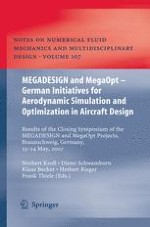2009 | OriginalPaper | Buchkapitel
Flexible Wing Optimisation Based on Shapes and Structures
verfasst von : Holger Barnewitz
Erschienen in: MEGADESIGN and MegaOpt - German Initiatives for Aerodynamic Simulation and Optimization in Aircraft Design
Verlag: Springer Berlin Heidelberg
Aktivieren Sie unsere intelligente Suche, um passende Fachinhalte oder Patente zu finden.
Wählen Sie Textabschnitte aus um mit Künstlicher Intelligenz passenden Patente zu finden. powered by
Markieren Sie Textabschnitte, um KI-gestützt weitere passende Inhalte zu finden. powered by
A multi-disciplinary optimisation (MDO) process chain for shape optimisation of a wing including the static deformation has been developed. The objective function, which should be minimized, is equivalent to the total aerodynamic drag force of an aircraft in stationary horizontal flight.
The CATIA V5 parametric model of the wing is controlled by the optimiser using an external CATIA-DesignTable. For four predefined wing sections there are parameters to control the thickness, camber, and twist independently giving in total 12 design parameters for the outer shape while maintaining a fixed wing planform. Additionally, two structure design parameters control the relative thickness change of the wing front and rear spars in combination with the upper and lower sheet thicknesses of the metallic wing box. The stiffness and the weight of the wing depend on these structural parameters.
An equivalent beam stick model is then automatically generated for any change of the wing box geometry. Iterative coupling between aerodynamic forces and weight forces (weight of wing- box, fuel, engines, payload, and engine thrust forces are taken into account) and equivalent beam stick bending and twisting is done until a steady state solution is obtained. Here, 12 coupling iterations are carried out using a Volume Spline technique to deform the CFD mesh according to the resulting equivalent beam stick deformation. TAU has been used as Navier-Stokes (RANS) solver on a structured mesh.
The optimiser chosen for this task is a Downhill Simplex method, which is very robust, does not require gradients, and performs well even with objective function evaluations that are subject to random noise (non-smooth). The reduction of the total drag force (objective function) and the total aircraft mass decreases due to wing box mass optimisation is shown while at the same time the aerodynamic performance
L
/
D
improves.
